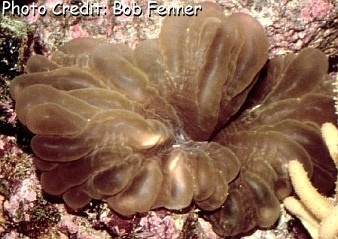
By Bob Goemans

Likely Reef Tank Suitable
Likely Fish-Only Tank Suitable
Range: Indo-West Pacific Ocean: Red Sea to the Great Barrier Reef.
Natural Environment: Inhabits protected reef environments having deep sandy bottoms and almost always attached to hard substrate, usually facing upwards. Its somewhat transparent expanded tissue balloon-like lobes, almost always twice the size of its skeleton, which is up to 4 inches (10 cm), are arranged around a central mouth opening. Its tentacles are usually only displayed at night when they feed on available plankton. Often found in various color combinations, including various shades of red and greens, but usually a dull brown color.
General Husbandry: This mostly circular in shape photosynthetic stony coral with a single large fleshy polyp is generally very hardy.
Appears to be quite sensitive to chemicals released by other corals, therefore should be given adequate space so it will not come in contact with other corals, even mushroom corals! As for placement, areas that receive low to moderate light and gentle water movement will suffice, with the polyp always facing upwards. Keep in mind this species is not found on soft substrates, therefore elevate properly and keep it away from strong currents and bright direct light.
As for feeding, this photosynthetic stony coral will do well, even in moderate light, without any special feeding. But it will take meaty-type foods, such as fortified brine shrimp, mysis, small pieces of marine fish/shrimp flesh, rotifers, and/or products containing Cyclop-eeze or similar type products when its feeding tentacles are displayed.
And it will sometimes display them if it senses food entering the aquarium during the daytime. To initiate this, have used freeze-dried krill squished between my fingertips in the aquarium water. Feeding, in my opinion, should not occur more than once every couple of weeks, as I've seen this coral, and others similar to this, go through some odd shape changes after feeding, and become abnormal looking thereafter for various timeframes.
This coral also seems to be a good indicator of water quality! When conditions are excellent, i.e., water parameters are near those in the wild, there's far greater polyp expansion than when water parameters become nutrient rich.
This is a moderately hardy, disease resistant stony coral and fairly common in the trade.
Taxonomy:
Kingdom: Animalia
Phylum: Cnidaria
Class: Anthozoa
Subclass: Hexacorallia
Order: Scleractinia
Family: Mussidae
Genus: Cynarina
FYI: When purchasing a specimen with highly inflated flesh, do not remove it from the water as the weight of the water in the flesh may damage or tear the flesh. Gently shake the specimen and allow the flesh to retract somewhat before removing.
Experience Level: Beginner
Diet: Photosynthetic/Plankton feeder
Temperament: Peaceful
Aquarium Environment: Reef or fish-only aquarium
Coral Safe: Yes
Fish Safe: Yes
Invertebrate Safe: Yes
Acclimation Time: 30 minutes+
Aquarium Hardiness: Moderate
Calcium (Ca): 380 - 430 mg/l
Alkalinity: 2.5 - 3.0 meq/l
Phosphate (PO4): <0.05 mg/l
Magnesium (Mg): approx. 1350 mg/l (relate to specific gravity)
Strontium (Sr) 8 - 10 mg/l
Temperature Range: 74 - 82°F (23 - 27°C)
Minimum Tank Size: 50 gallons
Lighting: PAR 250 - 300+
Water Movement: WM 1 - 2
Specific Gravity: 1.023 - 1.025
pH: 8.0 - 8.4
Iodine/Trace Elements Monitor/as necessary to maintain quality seawater.
